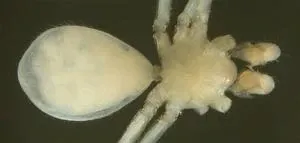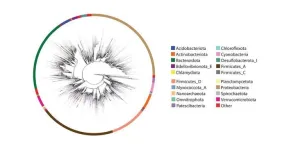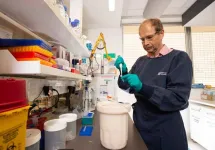(Press-News.org) NDIANAPOLIS—Researchers from Indiana University School of Medicine have diagnosed a Sumatran Orangutan at the Indianapolis Zoo with a rare genetic disease called Alkaptonuria. This is the first time the disease has been confirmed molecularly in a primate other than a human.
The six-year-old orangutan, named Mila, was born at the Indianapolis Zoo in 2016. Mila had a history of dark urine that turned brown upon standing since birth, but has never shown other symptoms. Researchers from the IU School of Medicine Department of Medical and Molecular Genetics collected and analyzed DNA, diagnosing Mila with alkaptonuria.
The research team recently published their findings in Molecular Genetics and Metabolism.
“This was an unexpected finding that ended years of questions about this animal,” said Marcus Miller, PhD, assistant professor of clinical medical and molecular genetics and principal investigator of the study. “We’re proud of this collaborative effort with the zoo that will hopefully lead to better care and treatment of Mila moving forward.”
Alkaptonuria is a rare, autosomal recessive disorder caused by deficiency of an enzyme called homogentisate 1,2-dioxygenase. As an infant, the only symptom is urine that turns black upon standing. Symptoms typically progress slowly, but can lead to chronic joint pain and decreased mobility later in life.
There have been several reports of the disease in non-human primates, but never any long-term studies, so it is unclear how the disease will impact Mila over time. However, having this diagnosis means that veterinarians don’t have to worry about other potential issues.
“I think the best part about these results is we can de-escalate some of the other studies that might have been recommended,” said Theodore Wilson, MD, assistant professor of clinical medical and molecular genetics. “We don’t need to use anesthesia for imaging, obtain a kidney biopsy or have guests or veterinarians worried. Even though her urine does still turn dark after being out in the environment, fortunately, now it doesn’t need to be a problem that is alarming.”
“People with this disease typically don’t develop symptoms until much later in life, usually in their 30s or 40s,” said Melissa Fayette, DVM, associate veterinarian for the Indianapolis Zoo. “We will continue to monitor Mila closely and perform regular preventive health exams to detect any secondary pathologies that may arise.”
In addition to Miller, Wilson and Fayette, other study authors include Kevin Booth, PhD; Ty Lynnes; Carolina Luna; and David Minich.
About Indiana University School of Medicine
IU School of Medicine is the largest medical school in the U.S. and is annually ranked among the top medical schools in the nation by U.S. News & World Report. The school offers high-quality medical education, access to leading medical research and rich campus life in nine Indiana cities, including rural and urban locations consistently recognized for livability.
END
IU researchers diagnose Indianapolis Zoo orangutan with rare genetic disease
2023-07-27
ELSE PRESS RELEASES FROM THIS DATE:
New $3 million grant supports research on leading cause of maternal mortality worldwide
2023-07-27
University of Missouri researchers are striving to find solutions to the leading cause of maternal mortality in the world — preeclampsia. For Laura Schulz, an associate professor of obstetrics, gynecology and women’s health in the University of Missouri School of Medicine, understanding the root causes of preeclampsia and other complicated, life-threatening maternal conditions is pivotal in advancing women’s health care.
Supported by a renewed $3 million grant from the National Institute of Child Health and Human Development (NICHD), Schulz and her team will use ...
Making renewable, infinitely recyclable plastics using bacteria
2023-07-27
Plastic waste is a problem. Most plastics can’t be recycled, and many use finite, polluting petrochemicals as the basic ingredients. But that’s changing. In a study published today in Nature Sustainability, researchers successfully engineered microbes to make biological alternatives for the starting ingredients in an infinitely recyclable plastic known as poly(diketoenamine), or PDK.
The finding comes from collaboration among experts at three facilities at the Department of Energy’s Lawrence Berkeley National Laboratory (Berkeley Lab): the Molecular Foundry, the Joint BioEnergy Institute ...
Short bursts of daily activity linked to reduced cancer risk
2023-07-27
Promising new research suggests a total of just 4.5 minutes of vigorous activity that makes you huff and puff during daily tasks could reduce the risk of some cancers by up to 32 percent.
Published in JAMA Oncology and led by the University of Sydney, Australia, the study used data from wearable devices to track the daily activity of over 22,000 ‘non-exercisers’. Researchers then followed the group’s clinical health records for close to seven years to monitor for cancer.
As few as four to five minutes of vigorous intermittent lifestyle physical activity or ‘VILPA’ was associated with a substantially lower cancer risk compared to those who undertook no ...
Johns Hopkins Applied Physics Laboratory restores cold sensation in amputees’ phantom limbs
2023-07-27
Johns Hopkins Applied Physics Laboratory (APL) researchers have developed one of the world’s smallest, most intense and fastest refrigeration devices, the wearable thin-film thermoelectric cooler (TFTEC), and teamed with neuroscientists to help amputees perceive a sense of temperature with their phantom limbs. This advancement, one of the first of its kind, enables a useful new capability for a variety of applications, including improved prostheses, haptics for new modalities in augmented reality (AR) and thermally-modulated therapeutics for applications such as pain management. The technology also has a variety ...
New resource harmonizes 16S and shotgun sequencing data for microbiome research
2023-07-27
Two leading sequencing techniques are no longer at odds, thanks to an international effort led by scientists at University of California San Diego. In a study published July 27, 2023 in Nature Biotechnology, the researchers debuted a new reference database called Greengenes2, which makes it possible to compare and combine microbiome data derived from either 16S ribosomal RNA gene amplicon (16S) or shotgun metagenomics sequencing techniques.
“This is a significant moment in microbiome research, as we’ve effectively rescued over a decade’s worth of 16S data that might have otherwise become obsolete in the modern world ...
Preventing weight gain: Yo-yo no-go zones for Australians
2023-07-27
There’s no doubt that Aussies love a good celebration. We’re all in when it comes to the weekend, and most of us can’t go past a Christmas celebration without a little bit of overindulging. But all this comes at a cost, and it’s taking a massive toll on our waistline.
Now, a world-first study from the University of South Australia exposes the real weight gains of everyday Australians, in a move to tackle overweight and obesity.
Funded by the NHMRC, and published in JAMA Open Network today, the study explored how weight changes across a 12-month period, finding that weight fluctuated throughout the year.
Specifically, ...
Closing cancer cell’s escape route
2023-07-27
Chemotherapy and radiotherapy aim to destroy cancer cells by inducing DNA double-strand breaks – damage that, once inflicted, usually causes the cells to die. But damage to a cell’s genetic material also activates a signaling pathway called IKK/NF-κB that helps prevent cell death, thus limiting the success of these treatments in patients.
NF-κB is a family of gene regulators that controls a wide variety of cellular processes – from immune responses to embryonic development – and is activated by the enzyme complex ...
Fiber-infused ink enables 3D-printed heart muscle to beat
2023-07-27
Over the last decade, advances in 3D printing have unlocked new possibilities for bioengineers to build heart tissues and structures. Their goals include creating better in vitro platforms for discovering new therapeutics for heart disease, the leading cause of death in the United States, responsible for about one in every five deaths nationally, and using 3D-printed cardiac tissues to evaluate which treatments might work best in individual patients. A more distant aim is to fabricate implantable tissues that can heal or replace faulty or diseased structures inside a patient’s heart.
In a paper published in Nature Materials, researchers ...
New technology promises rapid and reliable development of new diagnostic tests
2023-07-27
QUT researchers have developed a new approach for designing molecular ON-OFF switches based on proteins which can be used in a multitude of biotechnological, biomedical and bioengineering applications.
The research team demonstrated that this novel approach allows them to design and build faster and more accurate diagnostic tests for detecting diseases, monitoring water quality and detecting environmental pollutants.
Professor Kirill Alexandrov, of the QUT School of Biology and Environmental ...
Jinghui Zhang, Ph.D., elected Fellow of the International Society for Computational Biology
2023-07-27
(Memphis, Tenn. – July 27, 2023) St. Jude Children’s Research Hospital proudly announces that Jinghui Zhang, Ph.D., Member of the Department of Computational Biology, has been elected as a Fellow of the International Society for Computational Biology.
Zhang is one of 15 scientists given this distinction in 2023. She’s being honored for the development and application of innovative computational methods, discovering novel targets and accelerating research and genomic data sharing to advance the diagnosis, treatment and surveillance of pediatric cancers and survivors.
“I ...








